Fact is, the most successful whitetail hunters combine proven tactics with modern technology to augment their knowledge. They use woodsmanship to determine if there's a mature buck on their property, where deer feed, and how bucks move; trailcams just let them actually see racks. Here are some old-school tactics to enhance your quiver of new tricks.
Boots on the Ground
Google Earth and apps like OnX are wonderful for seeing the general lay of the land, but nothing beats boots on the ground to learn what's happening below the treetops. But don't just barge in anytime. During fall, you'll spook deer and spread scent; in spring and summer, deer display vastly different behavior than during the hunting season. Therefore, the best time to scout is the day after deer season ends.
At this time the woods are an open book with a story to tell. It's also one that's easier to read because the foliage is gone so you can see the bigger picture. If there's snow on the ground, even better. This is when you should walk ground to learn subtle ridge trails, draws, hidden pockets of cover, and any contours that dictate deer travel patterns. You'll find obvious signs, like trails, tracks, scrapes, and rub lines from the past rut. This intel will help you determine stand locations for the coming season.
Rub Lines
Hank Tassitano has been killing big bucks on public land since the 1960s. Back then, hunters had only their wits and a weapon to take a buck, which was a rare sight in itself. Tassitano has killed many mature bucks by hunting near rub lines, especially if he can find where two rub lines converge. While there is debate about the value of a rub, Tassitano feels strongly about them. "The size of the rub is generally indicative of the size of a buck," he says. "And while one rub just means that one buck was there once, a rub line usually means a buck routinely works that area."Trails
Understanding how deer traverse your property is vital. But don't think bucks just wander down trails like does. In October, when bucks transition into breeding mode, mature bucks walk perpendicular to major trails so they can maximize their chances of winding a doe. So even if your trail cam that's placed on a major trail reveals no mature bucks, it doesn't mean none are around. Rather, think like a buck and trust sign. Find places where bucks cruise so they're somewhat hidden yet can cross as many deer trails as possible.Food Sources
In fall, food sources alone are probably overrated for attracting big bucks. That's because most years there are so many food sources around, including mast, forbes, browse, crops, and fruit, that betting on one carries lower odds than betting on does to attract bucks. Nonetheless, deer must eat. So, you should be an expert on deer food.
Tracks
Tracks are the trailcams of yesteryear. A track made in dirt records when a deer was there and, to an extent, its size. In general, the tracks of mature buck are bigger than all other deer tracks in that area. In my area, for example, a track that measures three inches long is undoubtedly a mature buck, so I notice them. Tracks reveal where a buck has been and where he went.Rangefinder Trap
Old-school bowhunters were not dependent on laser rangefinders. While rangefinders are revolutionary for long-range shooting, they're also responsible for saving many bucks annually. That's because hunters who have become overly dependent on them often range a close-by buck when they should be shooting. Savvy hunters are accurate to 40 yards or better by using their natural depth perception. All it takes is practice.Sneakiness
Many modern hunters drive too close to their stands. Some are afraid of the dark; others are just lazy. Fact is, if a big buck is near your treestand — where you'd expect him — and he hears an ATV announce the presence of a human, he's gone. And then you'll wonder why you didn't see him that morning.Old-schoolers ninja in. Unless you know that deer are absolutely conditioned to living with trucks, say, on a busy ranch, this means parking a half-mile or more from your stand and sneaking in. Use cover and available natural features like creeks or rock ridges to disguise your entry.
没有评论:
发表评论